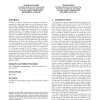1463 search results - page 273 / 293 » Feature selection based on the training set manipulation |
WWW
2007
ACM
14 years 9 months ago
2007
ACM
We describe a query-driven indexing framework for scalable text retrieval over structured P2P networks. To cope with the bandwidth consumption problem that has been identified as ...
WWW
2009
ACM
14 years 3 months ago
2009
ACM
Traditional relation extraction methods require pre-specified relations and relation-specific human-tagged examples. Bootstrapping systems significantly reduce the number of tr...
SIGIR
2006
ACM
14 years 2 months ago
2006
ACM
Large scale learning is often realistic only in a semi-supervised setting where a small set of labeled examples is available together with a large collection of unlabeled data. In...
BMCBI
2006
13 years 8 months ago
2006
The protein-protein interaction networks of even well-studied model organisms are sketchy at best, highlighting the continued need for computational methods to help direct experim...
CIKM
2008
Springer
13 years 10 months ago
2008
Springer
Learning a sequence classifier means learning to predict a sequence of output tags based on a set of input data items. For example, recognizing that a handwritten word is "ca...

